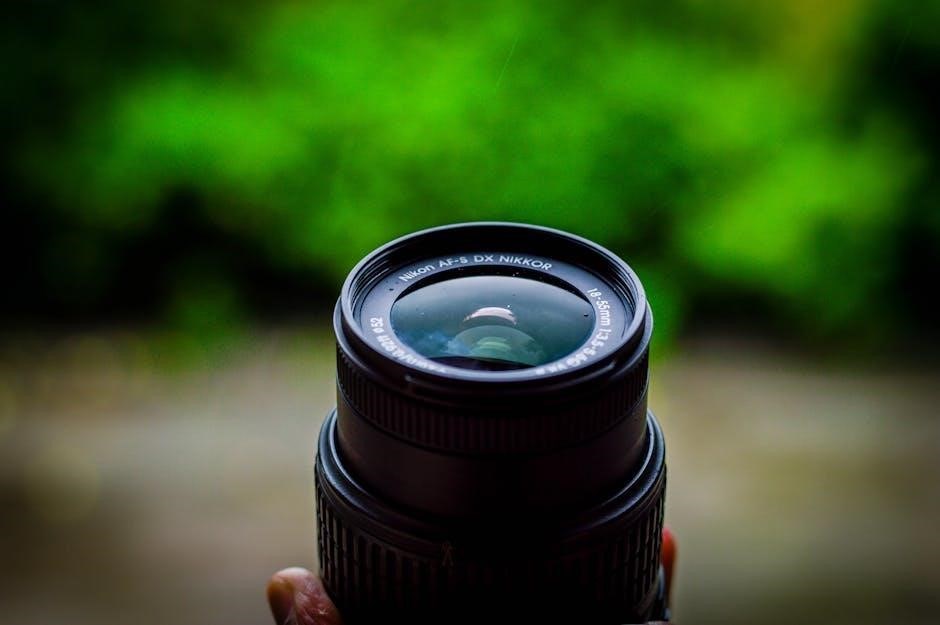Welcome to the Nikon D40x, a versatile single-lens reflex (SLR) digital camera designed for capturing stunning images. This manual will guide you in unlocking its full potential.
1.1 Overview of the Nikon D40x
The Nikon D40x is a high-performance, 10.2-megapixel digital SLR camera designed for enthusiasts and professionals alike. It features a CMOS sensor, 2.5-inch LCD screen, and an 11-point autofocus system for precise image capture. With its compact design and intuitive controls, the D40x offers advanced shooting modes, metering options, and custom settings. This camera is ideal for capturing detailed images, from landscapes to portraits, and is supported by a wide range of interchangeable lenses.
1.2 Key Features of the Nikon D40x
The Nikon D40x boasts a 10.2-megapixel CMOS sensor, delivering high-resolution images with excellent detail. It features a 2.5-inch LCD monitor for easy image review and menu navigation. The camera offers six preset Picture Controls for customizable image styles. With a built-in flash and support for external Speedlights, the D40x enhances lighting options. Its lightweight design and compatibility with AF-S and AF-I Nikkor lenses make it a versatile choice for photographers seeking quality and portability in various shooting environments.

Contents of the Nikon D40x User Manual
The manual covers essential guides, including a Quick Start Guide, Basic Operation, Advanced Guide, Menu Functions, Custom Settings, Troubleshooting, and Specifications to enhance your photography experience.
2.1 Quick Start Guide
The Quick Start Guide provides a concise introduction to the Nikon D40x, helping you begin photography immediately. It covers unpacking, charging the battery, and mounting the lens. Essential steps include setting the language, date, and time, as well as selecting basic shooting modes like Auto or Program Mode. The guide also explains how to use autofocus, flash, and review images on the LCD screen. Finally, it outlines how to transfer photos to a computer for editing and sharing. This section ensures a smooth start for new users.
2.2 Basic Operation
Mastering the basic operation of the Nikon D40x ensures a seamless photography experience. Begin by powering on the camera and familiarizing yourself with the mode dial and essential buttons. Navigate through menus using the multi-selector and OK button. Use the viewfinder for precise framing and the LCD screen for reviewing images. Understand how to adjust settings like ISO, autofocus, and flash. Practice shooting in different modes to get comfortable with the camera’s functionality and improve your photography skills effectively.
2.3 Advanced Guide
The Nikon D40x manual provides an advanced guide to refine your photography skills. Explore metering modes, including matrix, center-weighted, and spot metering, for precise light control. Learn to adjust autofocus settings for sharper images and customize white balance to match lighting conditions. Discover how to use custom settings to tailor the camera to your preferences. The manual also offers detailed explanations of advanced features, ensuring you maximize the D40x’s capabilities and achieve professional-quality results with ease.
2.4 Menu Functions
The Nikon D40x manual details the camera’s menu functions, providing access to key settings. The Shooting Menu allows adjustments for image quality, ISO sensitivity, and white balance. The Playback Menu offers options for reviewing, editing, and deleting images. The Setup Menu enables customization of camera settings, such as auto-timer, noise reduction, and LCD brightness. These menus are intuitively organized to help users optimize their shooting experience and maintain camera performance efficiently.
2.5 Custom Settings
The Nikon D40x manual explains how to tailor camera settings to your preferences. Custom settings allow you to modify autofocus modes, metering options, and noise reduction levels. You can also configure button functions and save these preferences for quick access. This feature enhances shooting efficiency by letting you personalize the camera to suit your style and ensure consistent results. The manual provides step-by-step guidance on navigating and saving custom settings for optimal performance.
2.6 Troubleshooting
The Nikon D40x manual includes a dedicated troubleshooting section to help resolve common issues. It covers error messages, camera freezes, and lens compatibility problems. The guide provides step-by-step solutions for issues like memory card errors, battery drain, and autofocus malfunctions. Additionally, it offers tips to prevent problems, such as proper camera maintenance and software updates. This section ensures users can quickly diagnose and fix issues, keeping their photography sessions uninterrupted and hassle-free.
2.7 Specifications
The Nikon D40x boasts a 10.2-megapixel CCD sensor, capturing high-quality images with precise detail. It features a 2.5-inch LCD screen for easy preview and playback. The camera supports SD memory cards and offers an ISO range of 100-1600. With a continuous shooting speed of 3 frames per second, it’s ideal for dynamic photography. The D40x is compatible with AF-S DX NIKKOR lenses, ensuring versatility in various shooting scenarios. Built-in flash, multiple autofocus modes, and a range of shooting modes further enhance its functionality.
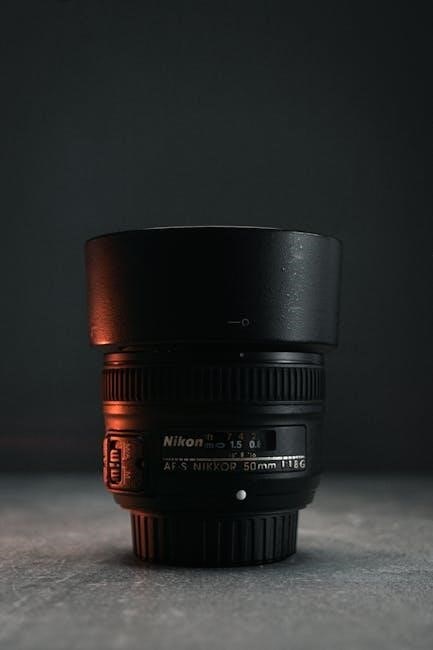
Basic Operation of the Nikon D40x
Mastering the Nikon D40x begins with understanding its layout, essential controls, and basic shooting modes, ensuring a smooth and intuitive photographic experience for users of all levels.
3.1 Understanding the Camera Layout
The Nikon D40x features a well-organized design, making it easy to locate and use its controls. The mode dial on top allows quick access to shooting modes, while the shutter release button is positioned for comfortable shooting. The AF-assist illuminator aids autofocus in low light. The LCD monitor displays settings and images, and the viewfinder provides a clear preview. The memory card slot and battery compartment are conveniently located. Familiarizing yourself with these components enhances your shooting experience. The diopter adjustment control ensures a sharp viewfinder image. The lens mount securely holds your Nikon lenses, and the external flash and AF mode button are within easy reach. Understanding each part’s function is key to mastering the camera.
3.2 Essential Buttons and Controls
The Nikon D40x features a range of essential buttons designed for intuitive operation. The Shutter Release Button is centrally located for easy access. The Mode Dial allows quick switching between shooting modes. The AF-Assist Illuminator aids autofocus in low-light conditions. The LCD Monitor displays settings and images, while the Viewfinder provides a clear preview. The Diopter Adjustment Control ensures a sharp viewfinder image. The Memory Card Slot and Battery Compartment are conveniently located. The Lens Mount securely holds Nikon lenses, and the External Flash and AF Mode Button are within easy reach.
3.3 Basic Shooting Modes
The Nikon D40x offers a variety of basic shooting modes to suit different photography needs. Auto Mode simplifies operation for beginners, automatically adjusting settings for optimal results. Program Mode (P) allows flexibility while maintaining automatic exposure. Shutter Priority Mode (S) lets you control shutter speed to freeze or blur motion. Aperture Priority Mode (A) enables precise aperture control for depth of field. Manual Mode (M) provides full creative control for advanced users. These modes make it easy to capture stunning images in various lighting conditions.
3.3.1 Auto Mode
Auto Mode is the simplest shooting option, designed for beginners or quick snapshots. The camera automatically adjusts exposure settings, including aperture, shutter speed, and ISO, ensuring well-balanced results. Focus is also handled automatically, making it ideal for point-and-shoot situations. While it limits manual control, Auto Mode delivers reliable outcomes in various lighting conditions, allowing you to focus on composition without technical adjustments.
3.3.2 Program Mode (P)
Program Mode (P) offers a balance between simplicity and control. The camera automatically sets aperture and shutter speed for optimal exposure, but you can adjust settings like ISO, white balance, and flash to customize results. Ideal for photographers who want flexibility without full manual control, Program Mode is versatile for various shooting scenarios, allowing creative input while maintaining ease of use.
3.3.3 Shutter Priority Mode (S)
Shutter Priority Mode (S) allows you to set the shutter speed manually, while the camera automatically adjusts the aperture for proper exposure. This mode is ideal for controlling motion effects, such as freezing fast-moving subjects or creating artistic blur. By adjusting the shutter speed, you can achieve creative results, like capturing sharp action shots or conveying motion in your images. It offers flexibility for photographers who want to prioritize specific visual effects in their photography.
3.3.4 Aperture Priority Mode (A)
Aperture Priority Mode (A) lets you manually set the aperture value, while the camera automatically adjusts the shutter speed for optimal exposure. This mode is perfect for controlling the depth of field, allowing you to isolate subjects or ensure both foreground and background are sharp. With aperture control, you can achieve creative effects, like a blurred background or a sharp landscape, giving you greater artistic control over your images. This mode is ideal for photographers who prioritize depth of field in their compositions.
3.3.5 Manual Mode (M)
Manual Mode (M) offers full creative control by allowing you to manually adjust both the aperture and shutter speed. This mode is ideal for experienced photographers who want precise control over exposure settings. It is particularly useful in challenging lighting conditions or when a specific artistic effect is desired. With Manual Mode, you can experiment with unique combinations of aperture and shutter speed to achieve the desired visual outcome, making it perfect for advanced photography techniques and customization.
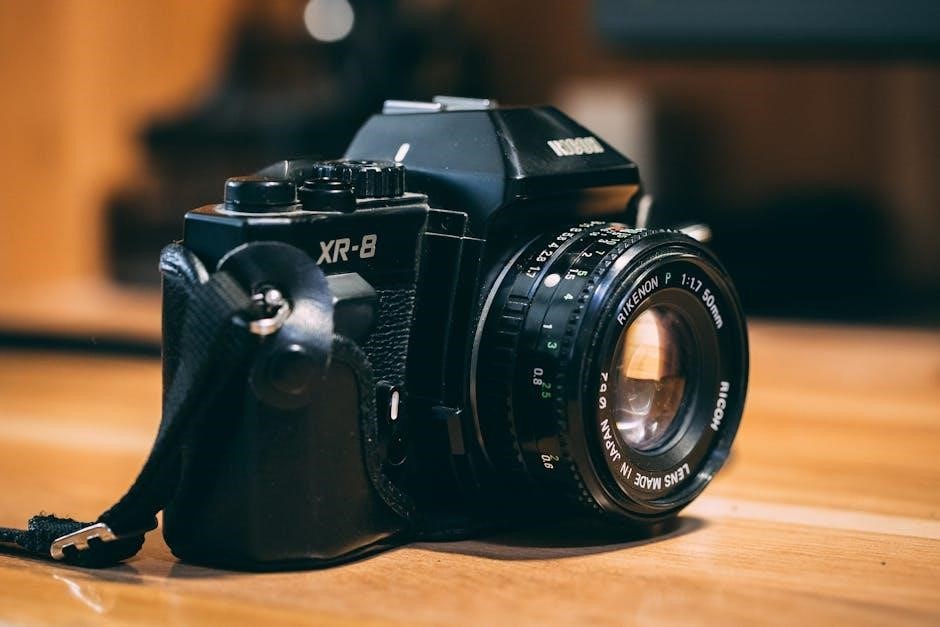
Advanced Guide
The Advanced Guide provides in-depth instructions for optimizing your Nikon D40x settings, including metering modes, autofocus, and white balance, to achieve professional-quality results in various shooting scenarios.
4.1 Metering Modes
The Nikon D40x offers three metering modes to ensure accurate exposure control. The 3D Color Matrix Metering II provides precise exposure by analyzing brightness, color, and composition. Center-Weighted Metering focuses on the central area, ideal for portraits, while Spot Metering measures a specific spot, perfect for high-contrast scenes. These modes help photographers achieve desired lighting effects, enhancing overall image quality and creativity in various shooting conditions.
4.2 Autofocus Modes
The Nikon D40x features advanced autofocus modes for precise subject capture. Single-Servo AF (AF-S) locks focus on stationary subjects, ideal for portraits. Continuous-Servo AF (AF-C) tracks moving subjects, perfect for action shots. Manual Focus (MF) allows full control for creative focus. The Multi-CAM 530 sensor ensures quick and accurate focus acquisition. Use the AF-lock feature to maintain focus on your subject while recomposing shots, enhancing flexibility in various shooting scenarios.
4.3 White Balance Settings
The Nikon D40x offers multiple White Balance settings to ensure accurate color representation. Choose from Auto, Daylight, Shade, Fluorescent, Incandescent, Flash, and Preset modes. Preset allows manual measurement for precise control. The camera’s 12-bit TTL phase detection system supports these settings, ensuring vibrant and natural colors in any lighting condition. Adjusting White Balance enhances image quality and reduces post-processing needs, making it ideal for photographers seeking professional results. Use the built-in AF-assist illuminator for improved focus in low-light scenarios. Customize your shots with these versatile White Balance options for optimal creativity.
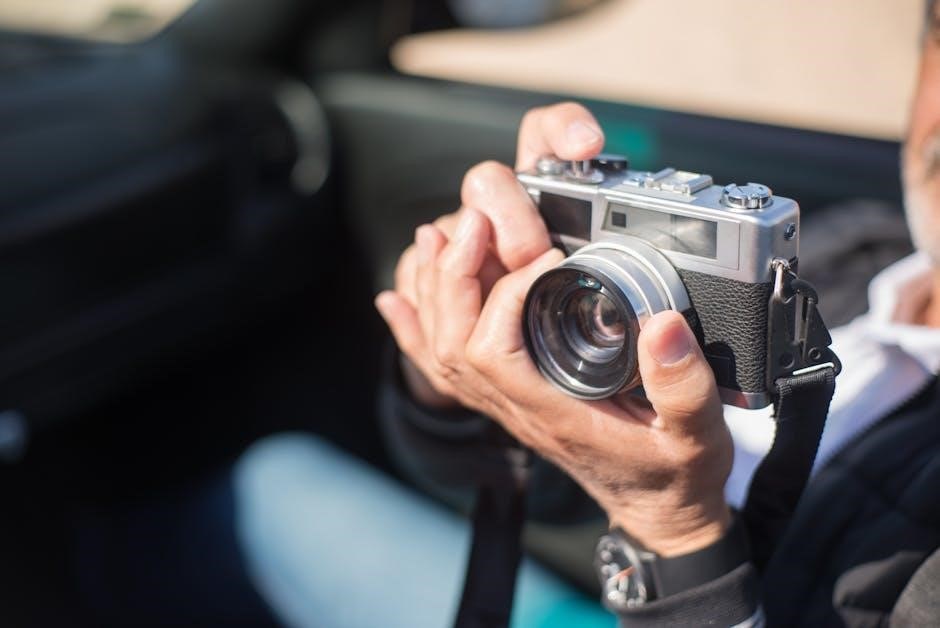
Menu Functions
The Nikon D40x features intuitive menu functions, including Shooting Menu, Playback Menu, and Setup Menu, allowing customization of camera settings for enhanced photography experiences. Explore these options to optimize your camera’s performance and tailor settings to your preferences for better results. These menus provide easy access to adjusting image quality, playback options, and system settings, ensuring a seamless user experience. Navigate through the menus effortlessly using the camera’s controls to fine-tune your photography workflow. Utilize the Custom Settings to save personalized configurations, streamlining your shooting process. The menu system is designed to be user-friendly, enabling quick adjustments and minimizing distractions while capturing moments. Discover the full potential of your Nikon D40x by exploring its comprehensive menu functions.
5.1 Shooting Menu
The Shooting Menu on the Nikon D40x allows you to configure essential camera settings for capturing images. Options include Image Quality, Image Size, White Balance, ISO Sensitivity, and Autofocus Mode. Adjust these settings to customize your photography experience, ensuring optimal results in various lighting conditions. The menu also provides options for RAW and JPEG file formats, enabling you to choose the best file type for your needs. Use the Shooting Menu to fine-tune your camera settings and achieve the desired look in your photos.
5.2 Playback Menu
The Playback Menu on the Nikon D40x offers tools for reviewing and managing your images. Options include Delete to remove unwanted photos, Rotate for adjusting image orientation, and Slide Show for viewing images in sequence. You can also access Histogram to analyze exposure levels and Highlight
5.3 Setup Menu
The Setup Menu provides options for customizing camera settings to suit your preferences. Adjust the date and time, select language, and set auto-off timers. You can also adjust LCD brightness and format memory cards. Additional options include setting the camera’s firmware version and resetting the camera to default settings. These settings allow you to personalize your Nikon D40x and ensure optimal performance for your photography needs.
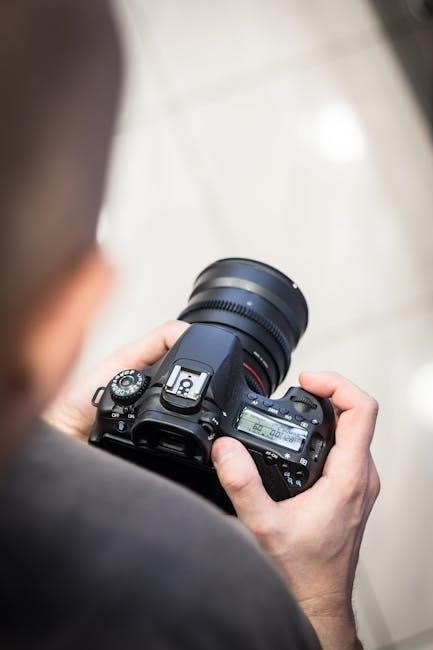
Custom Settings
Custom Settings offer personalized control over camera functions, ensuring tailored photography experiences. Adjust autofocus modes, metering modes, and white balance to suit your creative vision.
6.1 Custom Settings Options
The Nikon D40x offers a range of customizable settings to enhance your photography experience. Adjust autofocus modes, such as Single AF and Continuous AF, to capture sharp images. Metering modes, including Matrix, Center-Weighted, and Spot, allow precise exposure control. White balance settings, like Auto, Daylight, and Fluorescent, ensure accurate color reproduction. Additionally, you can fine-tune noise reduction, ISO sensitivity, and shooting modes to match your creative vision. These options provide flexibility for diverse shooting conditions and personal preferences.
6.2 Saving Custom Settings
To save your custom settings on the Nikon D40x, navigate to the Setup menu and select the “Save/Load Settings” option. Choose “Save Settings” and confirm to store your configurations. This feature allows you to preserve your preferred camera settings, ensuring they remain active even after turning off the camera. Saved settings are stored until manually reset, providing convenience for consistent shooting styles and quick access to your personalized camera configuration.

Retouching and Editing
The Nikon D40x offers built-in retouching tools for enhancing images. Use the Retouch menu to apply filters, correct red-eye, or adjust D-Lighting for improved photo quality.
These features allow quick edits without a computer, ensuring polished results straight from the camera.
7.1 Built-in Retouching Tools
The Nikon D40x provides a range of built-in retouching tools to enhance your images. These include D-Lighting for balancing contrast, Red-eye correction to remove red-eye effects, and Trim for cropping photos. Additionally, the camera offers options like Monochrome, Sepia, and Cyanotype for creative color filtering. These tools allow you to make adjustments directly on the camera, ensuring quick and convenient editing without the need for external software or a computer.
7.2 Using the Retouch Menu
Access the Retouch Menu by selecting it from the main menu; Here, you can apply various editing options to your images. Choose from tools like D-Lighting to improve contrast, Red-eye correction to fix portraits, and Trim to crop photos. Additionally, options like Monochrome, Sepia, and Cyanotype allow for creative filtering. Each tool is intuitively designed, enabling you to preview changes before saving. This feature simplifies editing, letting you enhance your photos directly on the camera without external software.
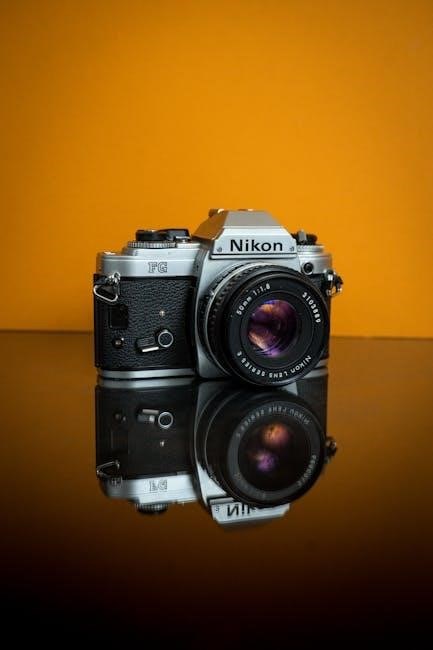
Connecting to External Devices
This section guides you through connecting your Nikon D40x to external devices. Transfer images to computers via USB, view photos on TV using A/V cables, and print directly with PictBridge.
8.1 Transferring Images to a Computer
Transfer images from your Nikon D40x to a computer using the provided USB cable. Connect the camera to your PC or Mac and access the memory card. Use Nikon Transfer or ViewNX software for easy import. Launch the software, select your camera or memory card, and choose the images to transfer. Files will be saved in formats like JPEG or NEF. Ensure your computer recognizes the device for a seamless transfer experience.
8.2 Viewing Images on a TV
To view images on a TV, connect the Nikon D40x using a video cable. Use the AV-out cable provided, inserting one end into the camera’s video port and the other into your TV’s AV input. Turn on the TV, select the correct AV channel, and navigate to the Playback Menu on your camera. Select the images or folders you wish to display. The camera will automatically transmit the images to the TV for viewing. This feature is ideal for sharing photos with family or friends.
8.3 Printing Images Directly
Print your images directly from the Nikon D40x using PictBridge-compatible printers. Connect the camera to a printer with a USB cable. Select images via the Playback Menu, choose print settings like paper size and quality, and start printing. This feature allows you to produce high-quality photos without a computer, making it convenient for instant sharing. Ensure the printer supports PictBridge for compatibility. Follow on-screen prompts to complete the printing process effortlessly.
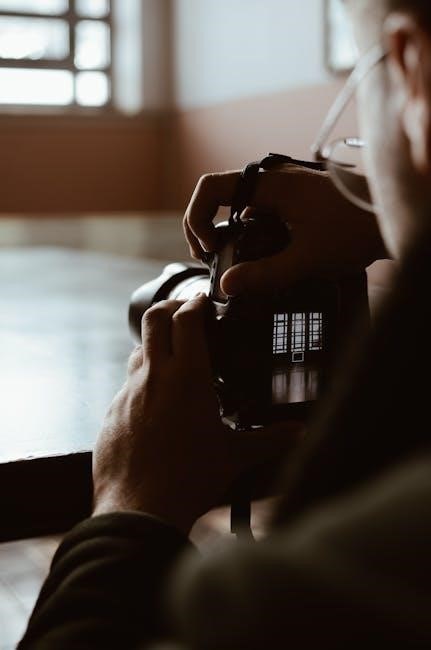
Troubleshooting Common Issues
Address common problems like error messages, battery issues, or camera freezes. Refer to the manual for solutions, such as resetting settings or cleaning the sensor for optimal performance.
9.1 Common Problems and Solutions
Encounter issues like camera freezes or battery drain? Check the manual for troubleshooting steps. Solutions include resetting settings, cleaning the sensor, or updating firmware. Ensure proper lens attachment and SD card functionality. If problems persist, contact Nikon support for assistance. Regular maintenance and software updates can prevent many issues, ensuring smooth operation and optimal image quality. Always refer to the manual for detailed solutions and best practices.
9.2 Understanding Error Messages
Error messages on your Nikon D40x, like “ERR” or “CARD NOT INITIALIZED,” indicate specific issues. The manual explains these codes, helping you identify problems quickly. For example, “ERR” often relates to lens or autofocus issues, while “CARD NOT INITIALIZED” suggests a memory card problem. The manual provides clear explanations and solutions, ensuring you can resolve issues efficiently. Familiarize yourself with these messages to troubleshoot effectively and maintain optimal camera performance. Always refer to the manual for accurate interpretations and fixes.
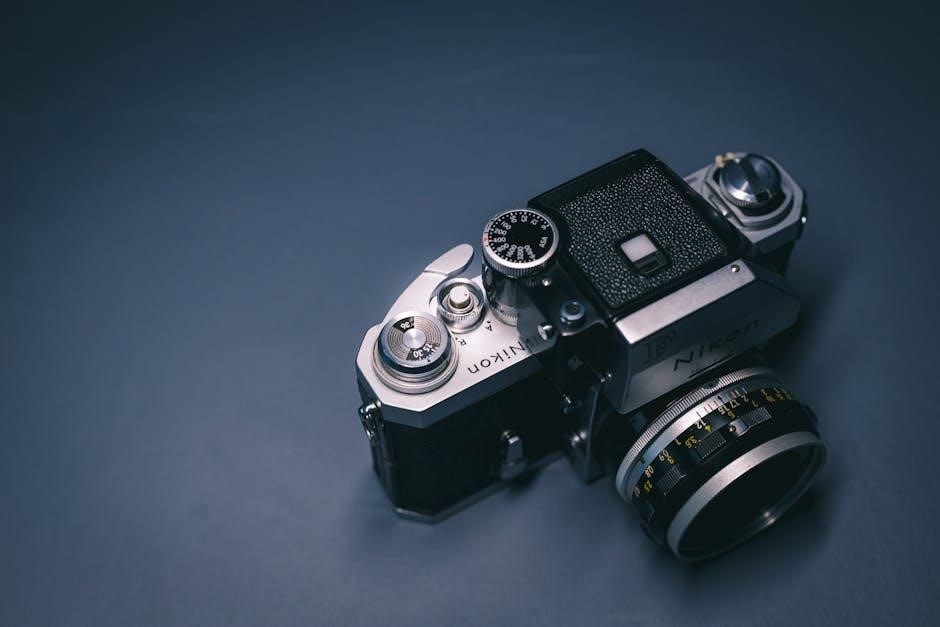
Specifications of the Nikon D40x
The Nikon D40x features a 10.2-megapixel APS-C CMOS sensor, delivering high-quality images with excellent detail. It offers an ISO range of 100-1600, ensuring versatility in various lighting conditions. The camera includes a 3-inch LCD monitor for previewing and reviewing shots. It supports SD and SDHC memory cards, providing ample storage for your photos. The D40x is compatible with Nikon F-mount lenses, offering flexibility in lens selection. With 11 autofocus points and a robust build, it is designed for both enthusiasts and professionals, balancing performance and portability effectively.
